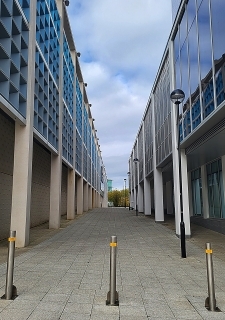A concrete environment: a brave new world
ONE SUNDAY MORNING in October 2023, we arrived in central Milton Keynes (‘MK’). The reason for our visit was to see an exhibition at the MK Gallery. I will describe the exhibition in a future posting. Although it was just after 10 am, there were few people around in the city centre. The little that we saw of central MK reminded me of trips to modern parts of cities in Eastern Europe before the collapse of the so-called ‘Iron Curtain’. However, in comparison with those places, central MK seemed much less lively.

Like New Belgrade and the new parts of Bratislava and Budapest, MK was built after WW2. In the 1960s, the UK government decided that to relieve the housing congestion that had developed in Greater London, new towns should be developed. MK was one of these. It was founded in 1967, and named after one of the villages in the area which the new city covers, rather than, as I had believed, in honour of two economists (John Maynard Keynes & Milton Friedman). Laid out in a grid pattern, it is modernist in conception. Having learned the mistakes made when planning earlier new towns in the UK, MK was designed to have commercial buildings that did not exceed six storeys, and residential that did not exceed three. However, a few taller buildings were added in the 21st century to provide the city with a central landmark. The city was designed by Melvyn Webber (1920-2006), who, according to an article in Wikipedia, believed:
“… telecommunications meant that the old idea of a city as a concentric cluster was out of date and that cities which enabled people to travel around them readily would be the thing of the future, achieving ‘community without propinquity’ for residents.”
Thus, MK has an amazing grid of roads that mostly intersect each other at roundabouts. It also has a high proportion of its area covered with open spaces (greenery and water features). MK was granted formal city status in August 2022. The part of MK we saw – and it was only a small part, but centrally located – has roads separated by wide tree-lined walkways. As already mentioned, the place reminded me of post-war urban developments in the formerly Communist countries of Central and Eastern Europe. I wondered whether the city has been a success. I have read that it makes an important contribution to the economy of the UK, but what I would like to know is how its inhabitants feel about living in what resembles a totalitarian utopia.



